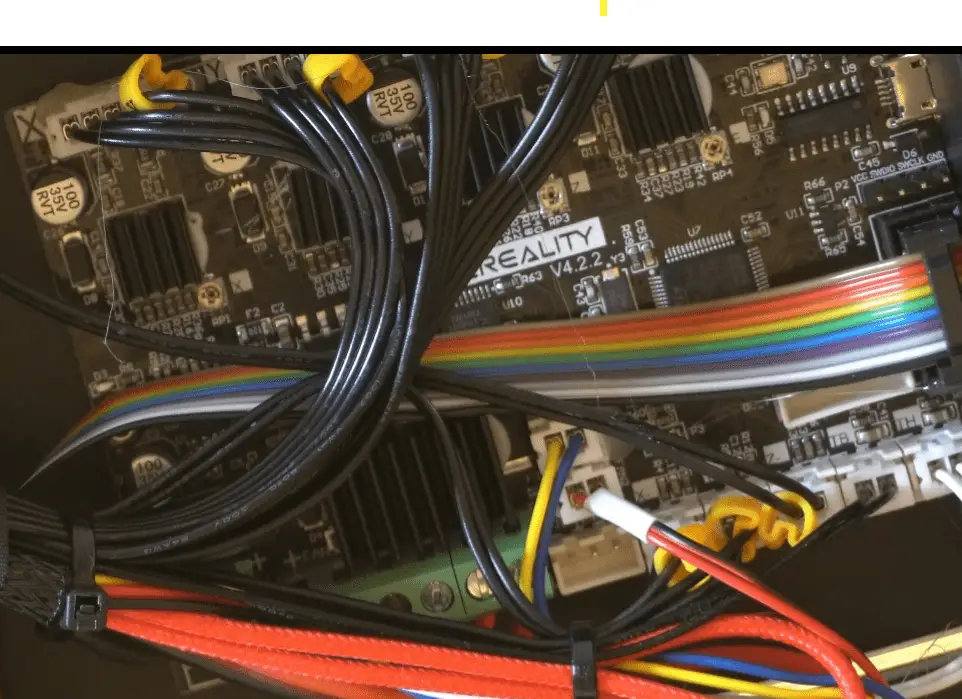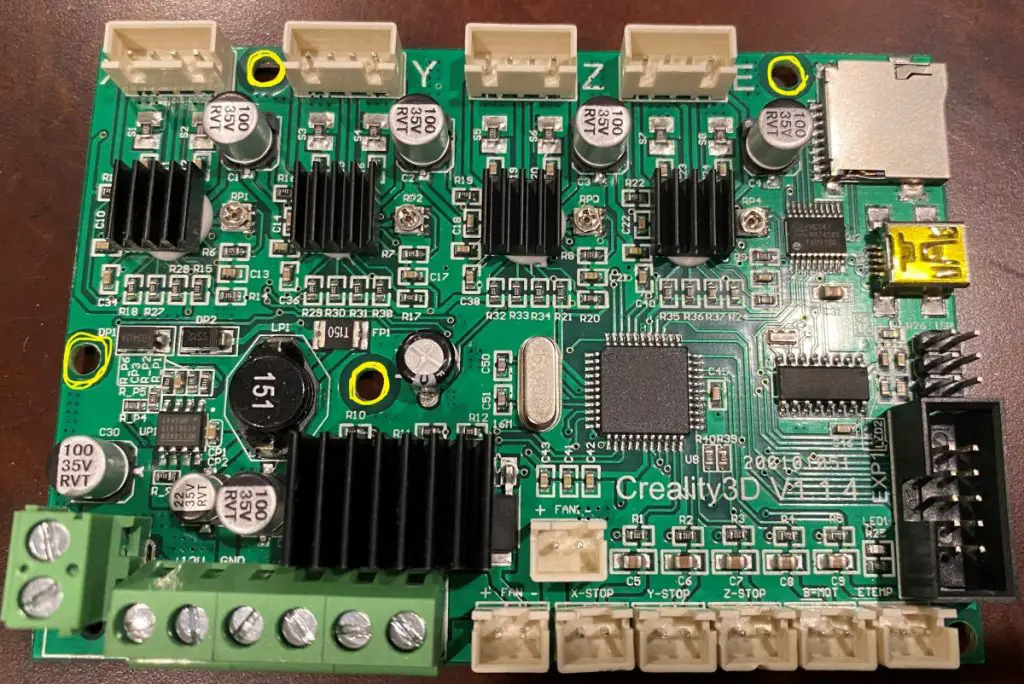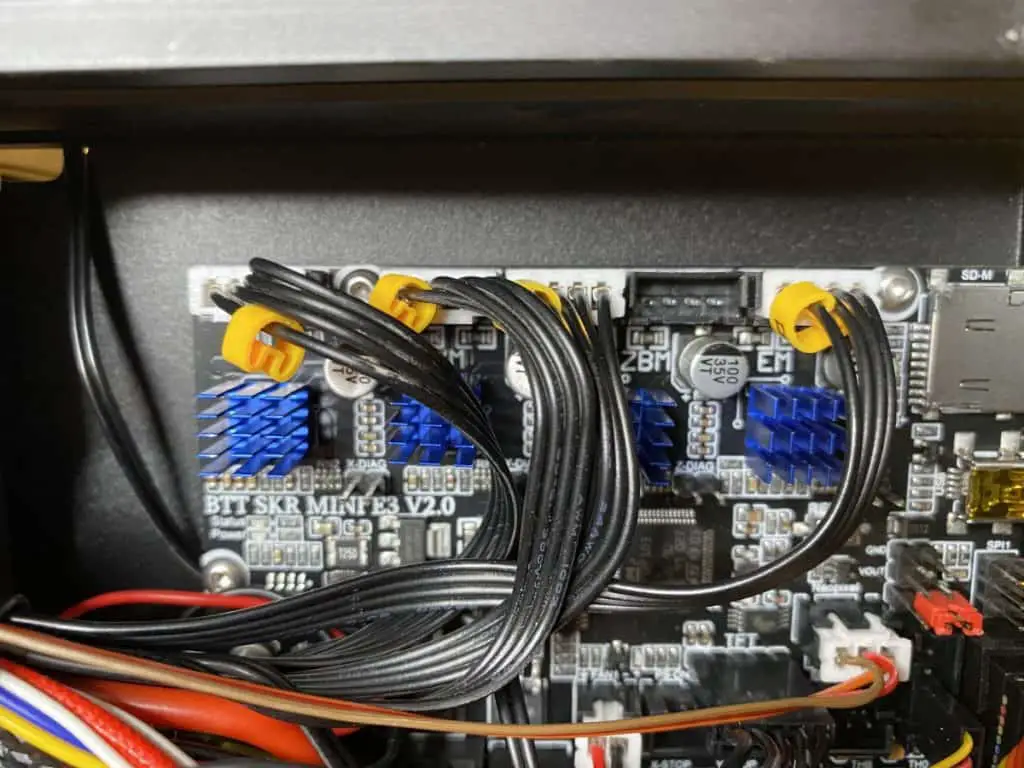Without stepper drivers, the motors on your printer wouldn’t rotate smoothly.
3D printer stepper motor drivers regulate the voltage supplied to the motor to move it fractions of a step instead of an entire one. So the motor turns slower and smoother. We call this microstepping and it produces higher quality prints. Stepper drivers also decrease vibration and noise.
One downside with many cheaper drivers is that the motors have less torque when receiving less power. But high-quality drivers like those from Trinamic have resolved issues like these which is why I only recommend them.
Here are a few things to consider when buying a stepper motor driver.

Developer
Some of the most trusted stepper driver developers are Trinamic Motion Control, Allegro MicroSystems, Texas Instruments, and OnSemi. My personal favorite of all these is Trinamic Motion Control (TMC) because their drivers offer advanced technology far ahead of any other brand.
With a massive number of patented technologies like StealthChop to eliminate noise and SpreadCycle for ultimate smoothness during printing, TMC drivers are the number 1 choice for 3D printers. Further below, we’ll look at more detailed information on these and other Trinamic patents.
Microstep Rating
Stepper drivers have microstep ratings that indicate how smoothly they can turn the motor. The rating is presented as a fraction, for example, 1/16, 1/32, and 1/64. So a rating of 1/16 means that the driver can turn the motor 1/16th of a full step, or 6.25%. These small movements create smooth rotations thus reducing artifacts in your prints.
A microstep rating of 1/256 is excellent for any 3D printer. That means that the drivers will supply just enough voltage to the motor coils for it to move 0.4% of a full step, a huge difference from a 1/16 (6.25%) rating.
The stepper drivers deliver less power to the motor coils to achieve this. But this also means that the motors will generate less torque, especially with cheaper drivers.
Chopper Modes
Manufacturers develop firmware for drivers which helps them perform better in a few different ways. Trinamic’s chopper modes are far more advanced than other manufacturers, here are the most popular ones and what they do.
StealthChop
StealthChop reduces the noise of your printer motors by regulating the voltage modulation which decreases frequencies created by fluctuations in the magnetic fields of the motor. It reduces the humming sound that motors produce after continuous work.
With StealthChop, you can expect a reduction in motor noise of 10dB or more.
StallGuard
This mode measures the energy flowing in and out of the motor, as well as the energy going back into the power supply to measure the load on the stepper motor without a sensor. So StallGuard allows you to use a sensorless rig if you choose to.
By eliminating limit switches, the amount of wiring required is greatly reduced, making the printer more visually appealing.
CoolStep
CoolStep regulates the supply voltage to the motor so that it only receives power when it needs to. This reduces the temperature by up to 80%.
CoolStep requires StallGuard to work, so you’ll always find them together. But keep in mind that you will have to parameterize it to work accordingly. Here’s the documentation on how to do it: trinamic.com
SpreadCycle
This chopper mode makes the motor run extremely smooth by adding a hysteresis function and optimizing the fast-decay for every cycle. It lowers the current gently so that the average and target currents match up nicely to create almost flawless sine waves. It also reduces current and torque ripple.
Price
Stepper drivers aren’t expensive with the most popular choices ranging between $5 to $12 each. So anything much less than that probably won’t perform well (unless it’s on sale), and anything that’s much more expensive is probably overpriced. You can also save a few bucks if you buy a package deal instead of just one. Most deals have a few drivers bundled because you’ll normally need more than one. Here are the types of bundled drivers you’ll find on amazon.com: TMC Drivers
How To Test A 3D Printer Stepper Driver
The easiest way to test a stepper driver is to swap it around with another driver on the board. Then check if the problem still occurs with the same motor or not. If the problem moves to the other motor, you can assume that the stepper driver is at fault.
How Long Do 3D Printer Stepper Driver Last?
Stepper motor drivers can last years if they’re not overloaded with voltage. For example, if you move the motor too fast by hand on the axis, you could blow the stepper driver by shooting too much voltage through it.
Plugging or unplugging motors or drivers while the printer is connected to the power can also blow the drivers. Overheating usually isn’t much of a problem since most drivers have thermal shutdown protection built into them and they’ll shut down if they get too hot. Of course, you don’t want that to happen while you’re printing so heatsinks are often used to cool stepper drivers.
If you think that your drivers are broken because they’re shutting down after some time, they might just be overheating. In this case, reduce the current on the potentiometer and test for thermal shutdown again. If they don’t heat up much and shut down, you need to add heatsinks before turning the voltage back up.
Do You Need A Driver For Each Stepper Motor?
Each stepper motor requires a stepper driver to take microsteps. So you’ll find four stepper drivers on an Ender 3 because there are four stepper motors. One for each of the axes and one for the extruder.
Which Driver Is The Best For The Stepper Motor?
For 3D printers, TMC2209 stepper drivers are the best because they’re reliable, quiet, and have good microstepping values. These drivers have patented technologies like StealthChop, CoolStep, and StallGuard that help them perform far better than other brands of stepper drivers.
They disperse heat effectively which makes them more reliable and less likely to shut down during a print.
The TMC2209 drivers have everything you need for a 3D printer and are the best choice for most people. The TMC2208 drivers are an excellent alternative if you have a lower budget and aren’t planning to go sensorless.
Here’s a list of the best stepper motor drivers from the very basic entry-level options to the most advanced.
A4988 Stepper Drivers
These drivers have been on the market for many years and are used in some lower-range Creality printers. Their main selling points are low price and reliability, but they don’t offer much more than that.
They won’t reduce the noise of your printer like TMC drivers do. The microstep rating is only 1/16 far from any of the Trinamic drivers on this list. I’ve also found a few people complaining about 1 or 2 of the drivers not working. If you receive one of these “duds”, follow the exchange process.
On the plus side, they give you directions and step control signals instead of driving the H bridge directly. You can also adjust the current limit which is good for a cheap stepper driver.
This is a budget option for those with only a couple of dollars to spare. Besides the random out-of-box failure here and there, these drivers are reliable if you don’t need the smooth operation of a 1/256-capable unit. Having said that, if you can afford it, rather go for the next driver on the list.
Here are some of the latest deals on amazon.com: A4988 Stepper Drivers
Manufacturer: Allegro MicroSystems
Microstep Rating: 1/16
Driver Modes: Slow current decay, mixed current decay, and automatic selection.

TMC2208
If you’re looking to greatly reduce the noise of your printer, this might be the stepper driver for you. They come equipped with StealChop to reduce the noise of the motors by over 10dB. The microstep rating of 1/256 is capable of handling pretty much any project you throw at it.
TMC2208s work with most mainboards including the popular MKS Gen L. Many owners of this board choose TMC2208 drivers because they make an excellent upgrade for the standard Ender 3.
Having said that, they don’t have StallGuard technology, so you won’t be able to run a sensorless rig.
This driver can be used with Marlin’s linear advance, you just need to turn stealthChop off and lock the extruder in spreadCycle mode.
Here’s the latest pricing on Amazon: Kingprint TMC2208
Manufacturer: Trinamic Motion Control
Microstep Rating: 1/256
Driver Modes: SpreadCycle and StealthChop
TMC2225
These drivers share most specifications with the TMC2208 above, with the only big difference being that these don’t have terminals to solder so they take up less space on the board. Being so close and compact to the board makes them vulnerable to overheating. So with the help of HTSSOP, it runs even cooler than the TMC2208.
It doesn’t have StallGuard technology so if you plan to go sensorless, you’ll have to get the TMC2130, TMC2209, or TMC2226 drivers detailed below.
Here are the latest deals on amazon.com: TMC2225 Stepper Drivers
Manufacturer: Trinamic Motion Control
Microstep Rating: 1/256
Driver Modes: SpreadCycle and StealthChop
TMC2130
You’ll find these drivers in many Prusa printers. Trinamic makes them specifically for 3D printers and has therefore packed them with all the chopping modes and other TMC technologies available.
However, TMC2130 drivers are slightly older and have lower motor supply and phase current values compared to TMC2209s which makes them a little weaker, but still far better than the previous drivers on the list.
TMC2130 drivers run reliably and don’t generate as much heat because of their lower power values. These drivers make for an excellent upgrade for any budget 3D printer, or for those that want to benefit from StallGuard and go sensorless. But for around the same price, I would suggest you rather opt for TMC2209 drivers.
Here are the latest deals on amazon.com: TMC2130 Stepper Drivers
Manufacturer: Trinamic Motion Control
Microstep Rating: 1/256
Driver Modes: CoolStep, StallGuard, SpreadCycle, and StealthChop
TMC2209
Besides having every Trinamic technology required for 3D printers, TMC2209 drivers can deliver a continuous current of 2.0A, with peaks of 2.8A. That’s a 0.5A increase from the TMC2208. These updated drivers also have CoolStep and StallGuard4. CoolStep optimizes the electrical consumption of the stepper motors and therefore reduces the heat they generate. You can achieve up to an 80% reduction in motor temperatures with CoolStep enabled.
StallGuard is another patented Trinamic technology that eliminates the need for stepper motor sensors. It accurately measures motor stops to make load measurements on the stepper motor.
A configuration pin allows you to switch between StealthChop and SpreadCycle.
Here are some of the latest deals for these drivers on amazon.com: TMC2209 Stepper Drivers
Manufacturer: Trinamic Motion Control
Microstep Rating: 1/256
Driver Modes: CoolStep, StallGuard, SpreadCycle, and StealthChop

TMC2226
TMC2226 drivers work extremely well just like the TMC2209 drivers. The difference between the two is that there are no terminals to solder on the TMC2226 drivers to reduce the amount of space required on the board.
Just like the TMC2225, this driver works with HTSSOP to reduce temperatures during operation. These are perfect for a sensorless setup but if you don’t need HTSSOP or a low driver profile, I suggest you purchase the TMC2209 drivers instead.
Here are the latest deals for these drivers on amazon: TMC2226 Stepper Drivers
Manufacturer: Trinamic Motion Control
Microstep Rating: 1/256
Driver Modes: CoolStep, StallGuard, SpreadCycle, and StealthChop
Related Articles
- Why Do 3D Printers Use Stepper Motors? (We’ve Got The Answer)
- 3D Printer Hotend – Complete Overview
- Why Do 3D Printers Make So Much Noise?
Conclusion
3D printers require stepper motor drivers to operate smoothly and accurately. The higher the microstep rating, the smoother the stepper motors will turn. Stepper drivers reduce noise and assist with many other things like motor heat and load management, as in the case with CoolStep and StallGuard.
I highly suggest buying the TMC2209 drivers unless you need them to be low-profile in which case I suggest the TMC2226 drivers.
Make sure you check out our YouTube channel, and if you would like any additional details or have any questions, please leave a comment below or join us on Discord. If you liked this article and want to read others click here.
